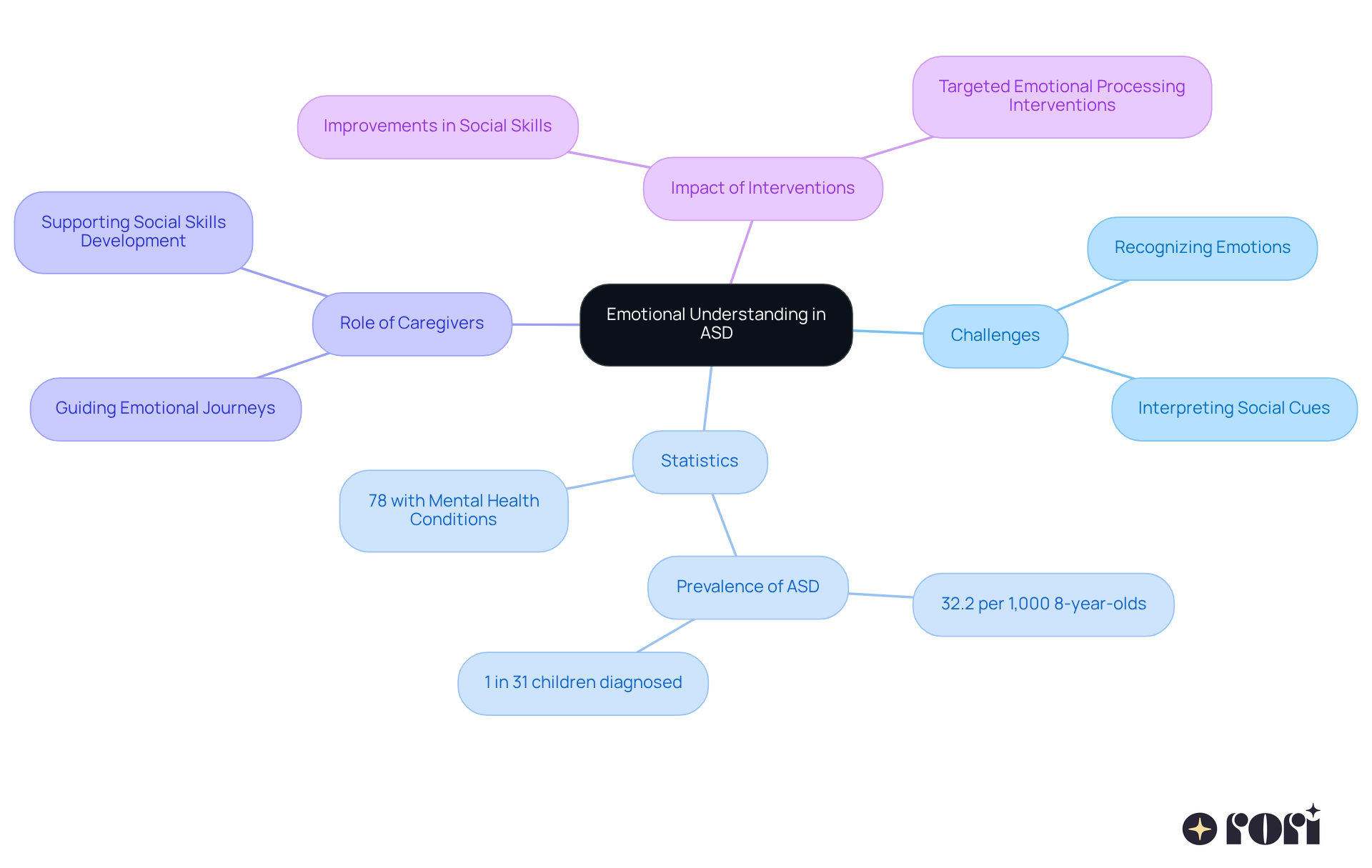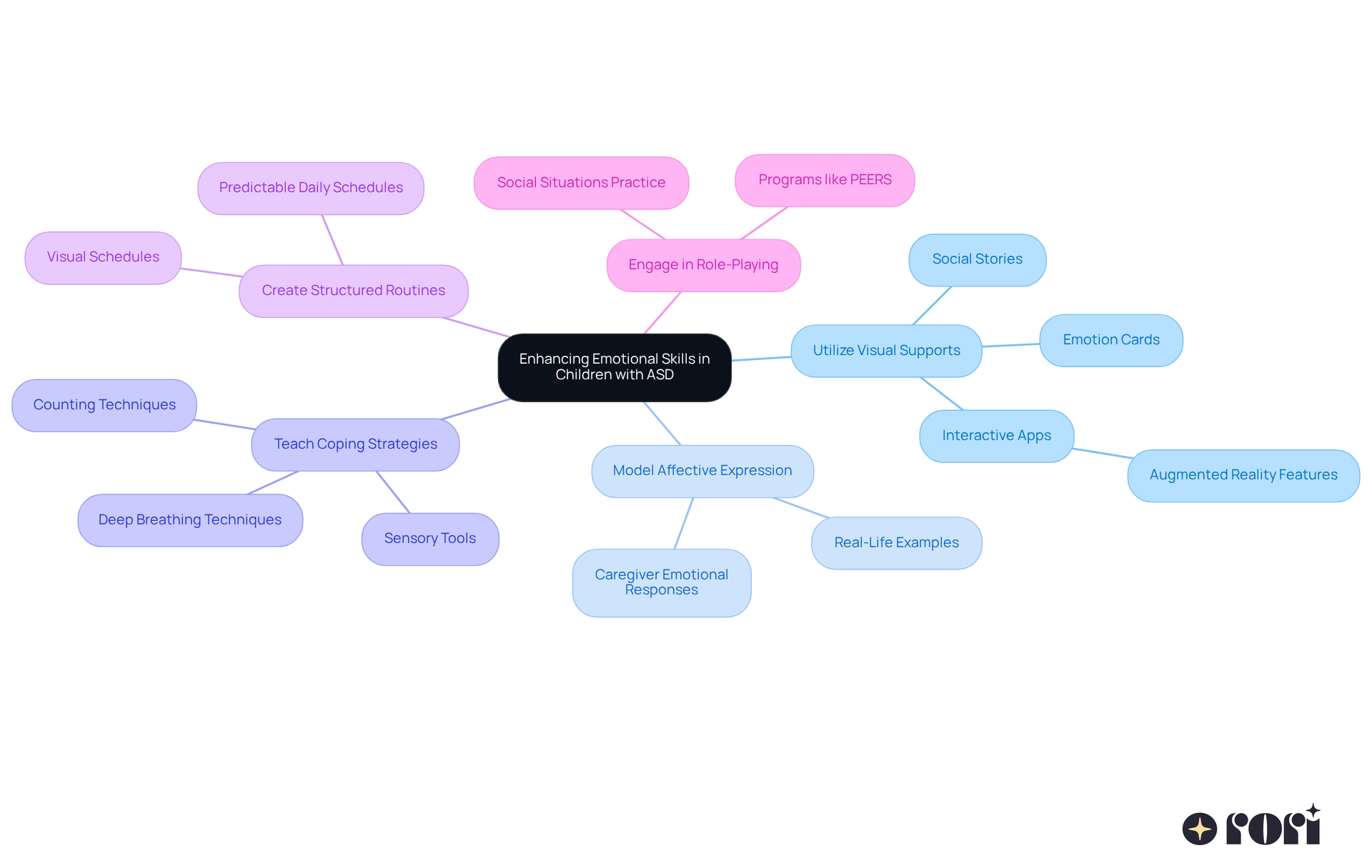Understanding emotions is such an important part of how we connect with each other, but for children with Autism Spectrum Disorder (ASD), it can feel like a real uphill battle. Recognizing, interpreting, and responding to feelings - both their own and those of others - are key skills that help build social connections and support mental well-being.
In this article, we’ll explore some expert strategies aimed at boosting emotional understanding in children with ASD. We’ll shine a light on the powerful impact of social-emotional learning and the crucial role that caregivers play in this journey. But you might be wondering: how can caregivers effectively bridge the gap between emotional awareness and practical application in everyday life? Let’s dive in together!
Understanding emotions is crucial, and building emotional understanding in children with ASD: expert advice is especially important. It’s all about recognizing, interpreting, and responding to our own feelings and those of others. Kids with ASD often find this tricky because they process things differently. For example, they might have a hard time picking up on facial expressions or social cues that tell them how someone else is feeling. This can make social interactions and managing emotions a bit challenging.
Did you know that nearly 78% of individuals with ASD also deal with at least one mental health condition? Anxiety and behavioral issues are particularly common. That’s why building emotional understanding in children with ASD: expert advice is crucial for helping these kids become more aware of their feelings. By doing this, we can really boost their social skills and overall mental health. Caregivers and educators play a crucial role here! By focusing on building emotional understanding in children with ASD: expert advice, they can guide young people through their emotional journeys, helping them build healthier relationships and improve their mental well-being.
There’s some encouraging news too! Case studies show that targeted interventions aimed at improving emotional processing can lead to significant improvements in social skills. This highlights just how powerful understanding feelings can be in the lives of young people with ASD. So, let’s explore this together and see how we can make a difference!

Building emotional understanding in children with ASD: expert advice emphasizes the significance of social-emotional learning (SEL) in assisting kids with autism spectrum disorder (ASD) to comprehend their feelings. It covers essential skills like self-awareness, self-regulation, and social interaction. Caregivers and educators can apply SEL strategies to support building emotional understanding in children with ASD: expert advice, enabling them to recognize their own emotions, understand how others feel, and develop coping mechanisms for their feelings.
Research shows that programs that include SEL can greatly improve social interactions and reduce behavioral challenges in kids with autism. For instance, role-playing scenarios have proven effective in helping young ones practice recognizing emotions in different situations, which boosts their responses in social settings. One study found that kids involved in SEL interventions made significant strides in recognizing emotions, especially basic feelings like happiness and sadness.
Plus, SEL fosters resilience and empathy, which are key for building meaningful relationships. Evidence suggests that kids who develop strong socio-emotional skills early on tend to feel more confident and adaptable, making it easier for them to navigate social situations. By nurturing these skills, SEL not only enhances emotional awareness but is also essential in building emotional understanding in children with ASD: expert advice, supporting their overall well-being and independence.
Let’s explore this together! By understanding the power of SEL, we can take steps to support our kids in their emotional journeys.

Enhancing emotional skills in children with ASD can feel like a big task, but there are some effective strategies that can really make a difference! Grounded in the principles of Applied Behavior Analysis (ABA) therapy, these approaches are not only scientifically proven but also often covered by insurance. Let’s explore this together!
Utilize Visual Supports: Visual aids like emotion cards, charts, and social stories are fantastic tools that help kids recognize and express their feelings. For example, using emotion cards with different facial expressions can spark conversations about emotions, making them easier to understand. Plus, interactive apps with augmented reality can really engage kids in identifying and practicing their feelings!
Model Affective Expression: It’s so important for caregivers to show appropriate responses in different situations. When adults express their emotions, it gives kids a real-life example to follow, helping them grasp emotional expression better. This aligns perfectly with the ABA approach, which highlights how crucial caregiver involvement is in reinforcing learning and improving behavior.
Teach Coping Strategies: Introducing calming techniques like deep breathing, counting, or using sensory tools can empower kids to handle overwhelming emotions. These strategies not only help in the moment but also build resilience over time, leading to better behavioral outcomes, as noted in ABA practices.
Create Structured Routines: Establishing predictable routines can significantly ease anxiety and help kids feel more secure. When they know what to expect throughout their day, it becomes easier for them to express their emotions. Research shows that children with ASD thrive in steady routines, which enhances their emotional regulation-a key focus of early intensive behavioral intervention (EIBI).
Engage in Role-Playing: Role-playing different social situations allows children to practice their reactions in a safe space. This interactive method not only strengthens their learning but also builds confidence in using these skills in real life. Programs like PEERS have shown that structured role-playing can improve social skills and emotional understanding, all backed by ABA principles.
By applying these techniques, you can create a supportive environment that emphasizes building emotional understanding in children with ASD: expert advice and expression. Plus, by learning about ABA principles and strategies, you’re empowered to make informed choices and provide better support for your child’s development. We’re here to help you every step of the way!

Involving guardians in the development of emotional skills is essential for building emotional understanding in children with ASD: expert advice, which aids in their ability to form lasting relational skills. When caregivers receive specialized education and training focused on building emotional understanding in children with ASD: expert advice and how to manage feelings, it can lead to amazing improvements. Here are some effective strategies to get caregivers involved:
Offer Training Sessions: Let’s set up sessions that teach guardians about personal growth, effective communication, and using visual aids. Research shows that organized training programs can lead to significant improvements in parenting skills, with an effect size of 0.72! This really boosts caregivers' ability to support their kids.
Promote Regular Training: Encourage caregivers to practice interpersonal skills at home, reinforcing what kids learn in therapy. This could be as simple as daily check-ins about feelings or using emotion cards during family chats. It’s all about creating a routine that helps everyone become more aware of emotions.
Establish Support Networks: How about forming support groups for guardians? This way, they can share experiences, challenges, and successes in helping their kids grow emotionally. Community support can really ease caregiver stress and enhance overall well-being, creating a nurturing environment for both caregivers and children.
Leverage Technology: Let’s not forget about technology! Incorporating apps or online resources can provide tools for tracking personal development and practicing techniques in fun ways. Innovative tech can make learning and connecting easier and more interactive.
By actively involving caregivers in these processes, we can enhance building emotional understanding in children with ASD: expert advice that suggests children are more likely to carry emotional skills into different settings. This leads to better emotional regulation and overall well-being. Let’s explore this together!

Building emotional understanding in children with ASD is such an important journey! It can really boost their social interactions and overall mental well-being. When kids with autism spectrum disorder learn to recognize and interpret emotions, they can navigate their feelings and relationships much more effectively. And guess what? This understanding doesn’t just help the kids; it also empowers caregivers and educators to create healthier emotional environments that promote growth and resilience.
Throughout this article, we’ve highlighted some key strategies that can make a difference. Think about the importance of social-emotional learning (SEL), the use of visual supports, and how actively involving caregivers in the emotional development process can really help. Each of these components plays a vital role in equipping children with ASD to recognize their own emotions, understand those of others, and respond appropriately in various social situations. The evidence supporting these approaches shows just how impactful targeted interventions can be in improving emotional understanding.
Ultimately, building emotional understanding in children with ASD is a journey that calls for collaboration, patience, and a commitment to ongoing learning. By putting into practice the expert tips and strategies we’ve discussed, caregivers and educators can truly make a meaningful difference in the lives of these children. Embracing this responsibility not only enriches the emotional landscape for kids with autism but also helps cultivate a more empathetic and supportive community for everyone. Let’s explore this together!
What is emotional understanding in the context of ASD?
Emotional understanding in the context of ASD involves recognizing, interpreting, and responding to one’s own feelings and those of others. It is crucial for social interactions and managing emotions, which can be challenging for children with ASD.
Why do children with ASD struggle with emotional understanding?
Children with ASD often process emotions differently, making it difficult for them to pick up on facial expressions and social cues that indicate how others are feeling.
What percentage of individuals with ASD also experience mental health conditions?
Nearly 78% of individuals with ASD deal with at least one mental health condition, with anxiety and behavioral issues being particularly common.
How can building emotional understanding benefit children with ASD?
Building emotional understanding can help children with ASD become more aware of their feelings, boost their social skills, and improve their overall mental health.
What role do caregivers and educators play in developing emotional understanding in children with ASD?
Caregivers and educators play a crucial role by guiding children through their emotional journeys, helping them build healthier relationships and improve their mental well-being.
What evidence supports the importance of emotional understanding for children with ASD?
Case studies show that targeted interventions aimed at improving emotional processing can lead to significant improvements in social skills for young people with ASD.